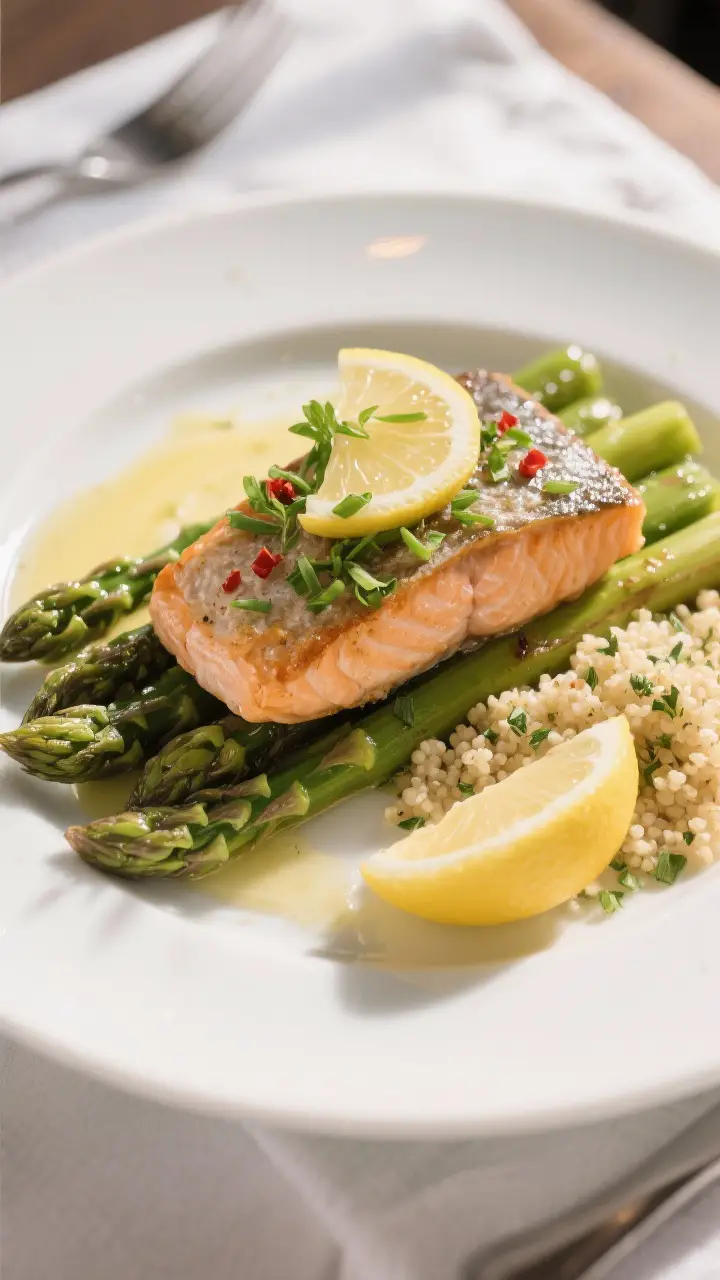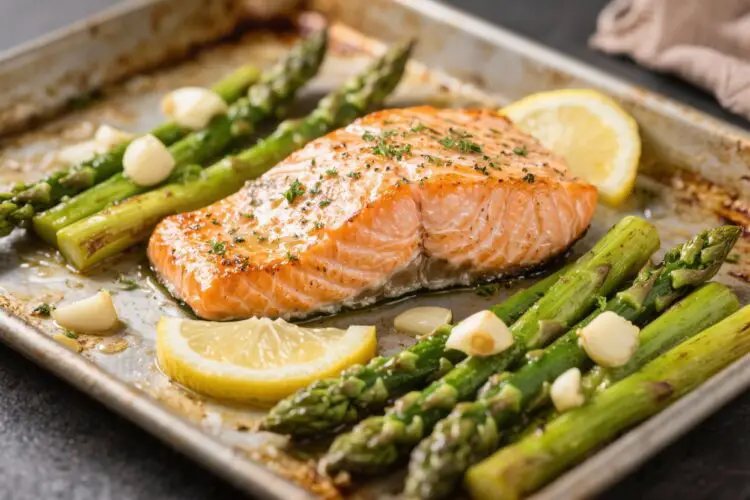This recipe is all about simple ingredients that deliver big flavor with minimal effort. You get tender, flaky salmon, crisp-tender asparagus, and a lemony garlic butter that ties everything together. It cooks on a single sheet pan, so cleanup is quick.
The whole meal feels fresh and light, but still satisfying. It’s the kind of dinner you can make on a busy night and still feel proud to serve.
Why This Recipe Works

Salmon and asparagus cook at about the same speed, which is perfect for sheet pan meals. The lemon juice brightens the fish, while garlic butter keeps it moist and flavorful.
A quick blast of high heat gives you a lightly crisp exterior and juicy interior. The result is a balanced dish that tastes restaurant-worthy with very little hands-on time.
Plus, the sheet pan method helps the asparagus caramelize slightly while the salmon bakes. A final squeeze of lemon and a sprinkle of fresh herbs make it feel fresh and clean.
It’s an easy template you can tweak based on what you have.
Ingredients
- 4 salmon fillets (about 6 oz each, skin-on or skinless)
- 1 lb asparagus, woody ends trimmed
- 2 tbsp olive oil, divided
- 3 tbsp unsalted butter, melted (or use extra olive oil for dairy-free)
- 3 garlic cloves, finely minced
- 1 large lemon, zested and juiced (plus extra wedges for serving)
- 1 tsp Dijon mustard (optional, for a bit of tang)
- 1 tsp honey or maple syrup (optional, to balance acidity)
- 1/2 tsp crushed red pepper flakes (optional, for heat)
- Kosher salt and freshly ground black pepper, to taste
- Fresh herbs (such as parsley, dill, or chives), chopped for garnish
- Lemon slices (optional, for roasting on top of salmon)
Instructions

- Preheat the oven. Set your oven to 425°F (220°C). Line a rimmed sheet pan with parchment for easy cleanup.
- Prep the asparagus. Toss the asparagus with 1 tablespoon olive oil, a big pinch of salt, and pepper. Spread in a single layer on the sheet pan, leaving space in the center for the salmon.
- Make the lemon garlic butter. In a small bowl, whisk together melted butter, remaining 1 tablespoon olive oil, minced garlic, lemon zest, 1–2 tablespoons lemon juice, Dijon, honey, red pepper flakes, 1/2 teaspoon salt, and a few grinds of pepper.
- Season the salmon. Pat the fillets dry.
Place them on the sheet pan, skin-side down if using skin-on. Spoon about half of the lemon garlic butter over the tops. Add a lemon slice to each fillet if you like.
- Roast. Bake for 10–12 minutes for medium doneness, depending on thickness.
The salmon should flake easily and read 125–130°F in the center with an instant-read thermometer. Thicker pieces may need 2–3 more minutes.
- Finish and serve. Brush the salmon and asparagus with the remaining lemon garlic butter. Squeeze over a little extra lemon juice, scatter fresh herbs, and add more salt and pepper if needed.
Serve right away with extra lemon wedges.
Keeping It Fresh
For meal prep, store salmon and asparagus in airtight containers for up to 2 days. Salmon is best the day it’s cooked, but it reheats gently. To reheat, use a low oven (275°F) for 8–10 minutes or a covered skillet over low heat to avoid drying it out.
If you have leftover sauce, save it separately and drizzle after reheating.
You can also serve leftovers chilled over greens with extra lemon and olive oil. The flavors hold up well when cold, and the texture stays pleasant if you don’t overcook the fish on day one.

Why This is Good for You
- Omega-3s: Salmon is rich in EPA and DHA, which support heart and brain health.
- Lean protein: It’s satisfying without being heavy, helping with satiety and muscle support.
- Fiber and micronutrients: Asparagus brings fiber, folate, and vitamins A, C, and K.
- Balanced fats: Olive oil and a touch of butter create a flavorful, heart-friendly fat profile.
- Low effort, high payoff: A simple cooking method that encourages cooking at home more often.
What Not to Do
- Don’t overcook the salmon. Dry salmon is the fastest way to ruin this dish. Start checking at 10 minutes.
- Don’t crowd the pan. Overlapping asparagus will steam instead of roast.
Use a second pan if needed.
- Don’t skip drying the fish. Patting the salmon dry helps the sauce cling and promotes better texture.
- Don’t use bottled lemon juice. Fresh lemon makes a big difference in flavor and aroma.
- Don’t forget salt. Proper seasoning wakes up the lemon and garlic so the dish tastes balanced.
Variations You Can Try
- Herb swap: Use dill and chives for a classic seafood vibe, or basil and parsley for a brighter, summery taste.
- Garlic parmesan: Sprinkle 2–3 tablespoons freshly grated Parmesan over the asparagus in the last 3 minutes of roasting.
- Mediterranean twist: Add cherry tomatoes, olives, and capers to the pan. Finish with a drizzle of extra-virgin olive oil.
- Spicy version: Use more red pepper flakes or a pinch of smoked paprika for warmth.
- Citrus mix: Combine lemon with a little orange or grapefruit zest for a layered citrus flavor.
- Dairy-free: Skip the butter and use all olive oil. Add a touch more Dijon for body.
- Vegetable swap: Broccolini, green beans, or thin carrot sticks roast well at the same temp.
Keep pieces similar in size.
- Grain bowl: Serve over quinoa, rice, or farro with extra herbs and a spoonful of yogurt or tzatziki.
FAQ
Can I use frozen salmon?
Yes. Thaw it overnight in the fridge or under cold running water while still sealed. Pat very dry before seasoning.
Frozen fillets can retain extra moisture, so drying is key for good texture.
How do I know when salmon is done?
Look for flakes that separate easily with a fork and a slightly translucent center. An instant-read thermometer should read about 125–130°F for medium. It will continue to cook slightly from residual heat.
What if my asparagus is thick?
For thicker stalks, roast them alone for 5 minutes before adding the salmon to the pan.
This helps them become tender without overcooking the fish.
Can I make this without butter?
Absolutely. Use all olive oil. If you want a richer feel without dairy, add a spoonful of tahini to the sauce for a creamy texture.
Do I need to remove the salmon skin?
No.
Skin-on is fine and can help keep the fillet moist. After roasting, the flesh will lift off the skin easily if you prefer not to eat it.
What should I serve with it?
Keep it simple with roasted potatoes, couscous, or a green salad. A lemony yogurt sauce or a dollop of pesto also pairs nicely.
Can I cook this in an air fryer?
Yes, in batches.
Air fry at 390°F. Asparagus takes about 6–8 minutes; salmon takes about 7–10 minutes depending on thickness. Check early to avoid overcooking.
How can I make it gluten-free?
The base recipe is naturally gluten-free.
Just confirm your Dijon is gluten-free if using a specialty brand.
Why add honey or mustard?
A touch of mustard adds body and helps the sauce cling. A small amount of honey balances the lemon’s acidity without making the dish sweet. Both are optional but add nuance.
Final Thoughts
This Sheet Pan Lemon Garlic Salmon with Asparagus is proof that a great dinner doesn’t need to be complicated.
It’s bright, balanced, and weeknight-friendly, with just enough flair to feel special. Keep this one in your rotation, tweak it with seasonal herbs, and enjoy a fresh, healthy meal with almost no cleanup. When you want something fast and satisfying, this is an easy yes.
Printable Recipe Card
Want just the essential recipe details without scrolling through the article? Get our printable recipe card with just the ingredients and instructions.

